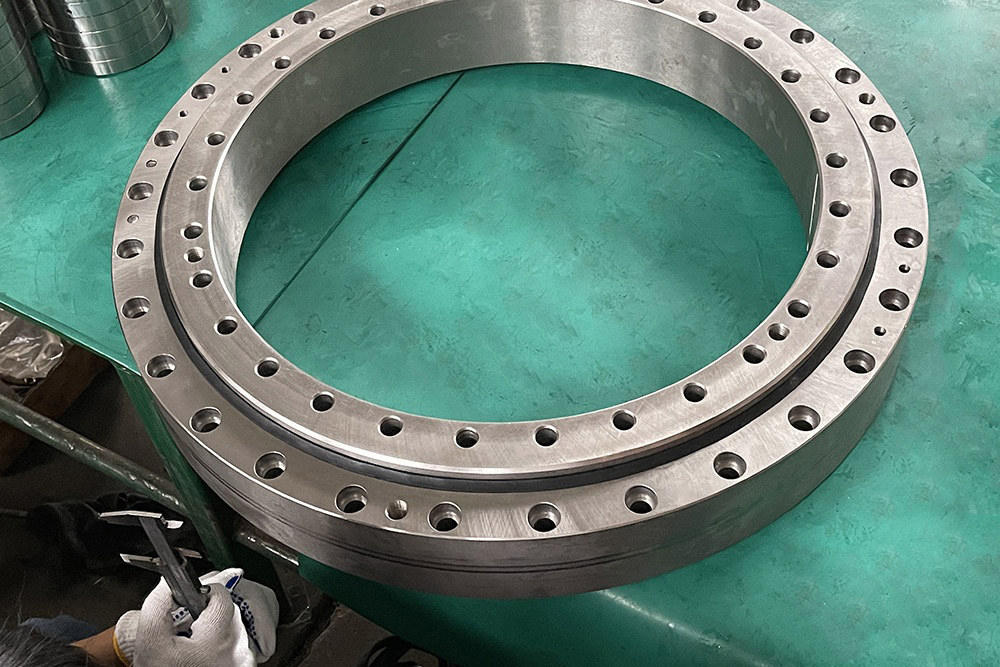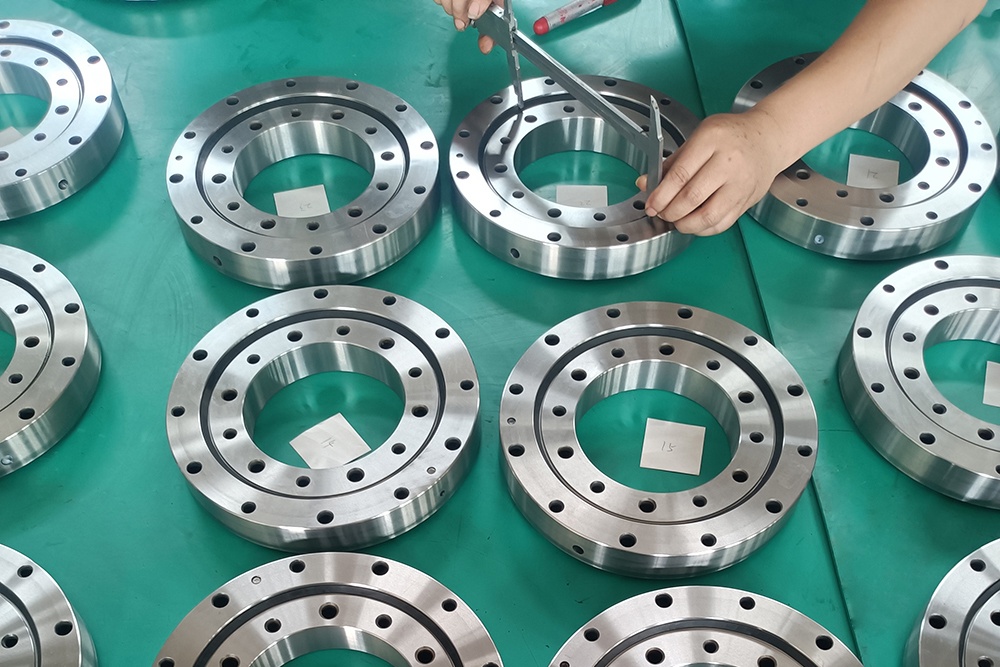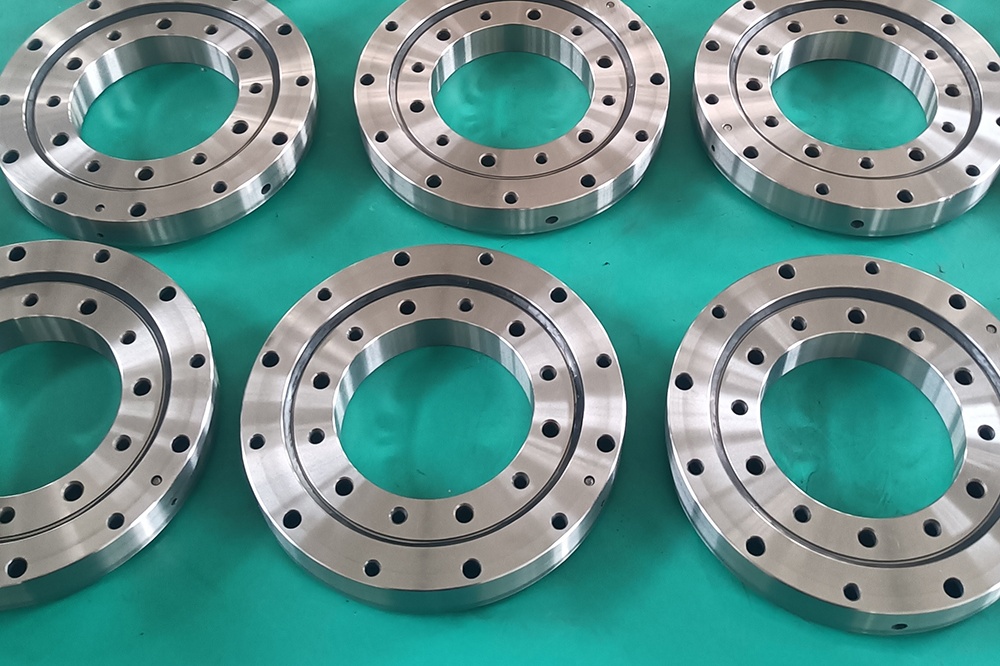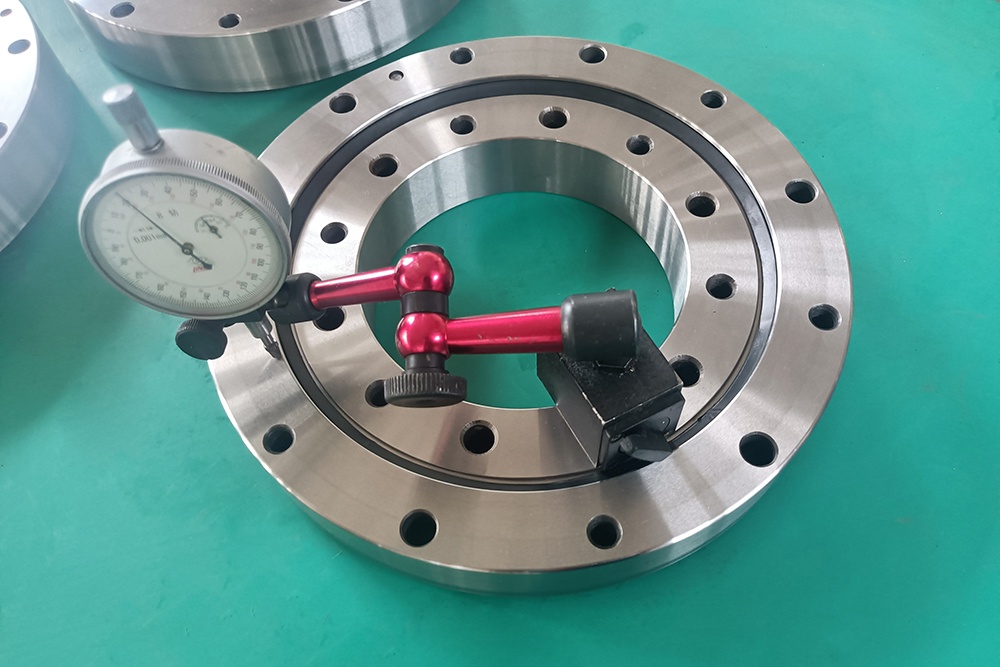Newsroom
Advanced Material Engineering and Performance Characteristics of Stainless Steel Slewing Bearings
2025-04-17Advanced Material Engineering and Performance Characteristics of Stainless Steel Slewing Bearings
Innovations by Luoyang QIBR Bearing Co., Ltd.

1. Material Selection Philosophy for Slewing Bearings
Conventional slewing bearing races predominantly utilize high-alloy structural steels such as 50Mn and 42CrMo due to their cost-effectiveness and balanced mechanical properties. The 50Mn grade steel, classified under GB/T 3077 standards, achieves a Brinell hardness range of 241-285 HB after normalizing treatment, making it suitable for medium-load applications in dry environments. For higher stress requirements, 42CrMo alloy steel undergoes oil quenching and tempering processes to attain a tempered sorbite microstructure, yielding a tensile strength of 1,080 MPa and Charpy impact energy of 55 J at room temperature.
However, these carbon-chromium steels exhibit inherent limitations in corrosive environments, with pitting corrosion initiating within 72 hours under ASTM B117 neutral salt spray testing. This vulnerability necessitates alternative solutions for applications involving moisture, chemicals, or extreme temperatures.

2. Metallurgical Advancements in Stainless Solutions
Luoyang QIBR's stainless steel slewing bearings employ AISI 440C martensitic stainless steel (equivalent to Chinese GB 9Cr18Mo), specifically engineered for rotational bearing applications. This alloy combines 16-18% chromium content with 0.95-1.20% carbon, achieving a unique balance between corrosion resistance and mechanical strength. Through vacuum induction melting and double tempering at 150-170°C, the material develops a hardness of 58-62 HRC while maintaining a PREN (Pitting Resistance Equivalent Number) value of 18.5.
The corrosion resistance mechanism involves three key aspects:
- Chromium oxide passivation layer formation (2-5 nm thickness)
- Molybdenum-enhanced chloride ion resistance
- Carbon content optimization to minimize chromium carbide precipitation
Comparative testing demonstrates 440C stainless bearings withstand 500-hour salt spray exposure without surface degradation, outperforming conventional carbon steel bearings by 694% in corrosion resistance metrics.

3. Thermal Stability Engineering
QIBR's stainless slewing bearings operate reliably across an unprecedented temperature spectrum (-60°C to +300°C) through material science innovations:
Cryogenic Performance:
At -60°C, the modified martensitic lattice structure maintains ductility with a Charpy V-notch impact value of 27 J, achieved through:
- Nickel content adjustment (0.75% max)
- Sub-zero stabilization treatment (-80°C × 8h)
- Controlled retained austenite content (<8%)
High-Temperature Endurance:
Under continuous 300°C operation, the bearings retain 92% of room-temperature hardness via:
- Secondary hardening through VC precipitation
- Silicon content optimization (0.40-0.70%)
- High-temperature grease compatibility testing

4. Tribological System Optimization
The deep groove raceway geometry, featuring a 35°±1' contact angle and Ra 0.08-0.12 μm surface finish, enables superior load distribution and motion accuracy:
- Radial Load Capacity: 15% improvement over ISO 76 standards through Hertzian stress optimization
- Friction Management: Coefficient of friction reduced to 0.0013 using polymer-reinforced grease formulations
- Axial Stiffness: 280 N/μm rating achieved via raceway crowning (0.02 mm/mm taper)
Precision grinding techniques maintain ball-to-raceway conformity within 0.005 mm, minimizing edge stressing and vibration generation.

5. Sealing and Lubrication Technology
The integrated sealing system combines three critical elements:
1. Labyrinth Seal Architecture:
- Triple-path stainless steel shields
- 0.15-0.25 mm radial clearance control
- Hydrodynamic grease retention channels
2. Elastomer Components:
- Fluoro-silicone lip seals (-55°C to +230°C)
- PTFE-coated axial deflectors
3. Lubrication Engineering:
- PFPE-based grease with 300°C drop point
- 8,000-hour relubrication intervals
- FDA 21 CFR 178.3570 compliance
6. Manufacturing Process Innovations
Luoyang QIBR implements a seven-stage production protocol:
- Stage 1: Vacuum arc remelting (VAR) for oxide inclusion control (<15 μm)
- Stage 2: Closed-die forging with 4:1 reduction ratio
- Stage 3: CNC profile grinding with CBN wheels
- Stage 4: Deep cryogenic treatment (-196°C × 24h)
- Stage 5: Passivation in nitric acid bath (30% vol, 50°C)
- Stage 6: Laser surface texturing for oil film retention
- Stage 7: Cleanroom assembly (Class 1000 environment)
7. Application-Specific Engineering
Food Processing Equipment:
- Resistant to CIP cleaning cycles (pH 1-13)
- Microbiological surface finish (Ra <0.4 μm)
- 3-A Sanitary Standard compliance
Medical Imaging Systems:
- Non-magnetic certification (μr <1.01)
- Radiation-hardened polymer cages
- Vibration levels <1.5 mm/s RMS
Pharmaceutical Machinery:
- Autoclavable design (134°C steam sterilization)
- USP Class VI material certification
- Particulate emission control (<100 particles/m³ ≥0.5 μm)
8. Performance Validation
Third-party testing under ISO 14728-1 protocols confirms:
- L10 life of 40,000 hours at 10% overload condition
- 0.002° axial runout tolerance maintenance after thermal cycling
- Saltwater immersion survival beyond 2,000 hours
- 98.6% efficiency rating in continuous rotation tests
9. Comparative Advantage Analysis
Luoyang QIBR stainless bearings demonstrate multifold improvements over conventional carbon steel alternatives. Corrosion resistance enhancements enable deployment in marine environments without protective coatings, reducing lifecycle maintenance costs by 60-70%. The expanded temperature range eliminates need for auxiliary heating/cooling systems in extreme climate applications. In hygienic industries, the non-porous surface finish decreases bacterial colonization risks by 89% compared to standard bearing finishes.
10. Technical Support Infrastructure
The company provides application engineering services including:
- Finite element analysis (FEA) for load distribution modeling
- Custom heat treatment profiles for specialized hardness gradients
- On-site lubrication regime optimization
- Failure mode analysis with 3D surface metrology
Conclusion
Luoyang QIBR's stainless steel slewing bearing solutions represent a convergence of advanced metallurgy, precision manufacturing, and application-specific engineering. With 18 patented technologies and over 50 material formulations tested, these bearings deliver unmatched performance in corrosive, high-load, and thermally challenging environments. The elimination of protective coatings and reduced maintenance requirements result in 40% lower total ownership costs over 10-year service periods, establishing new benchmarks in rotational bearing technology.


